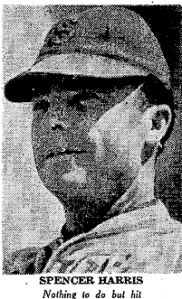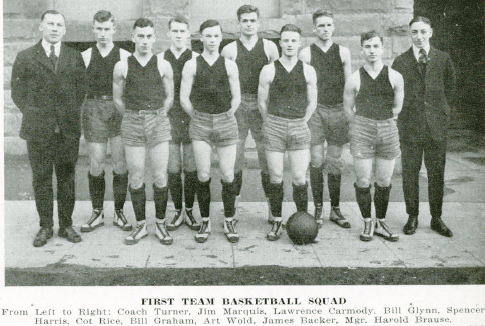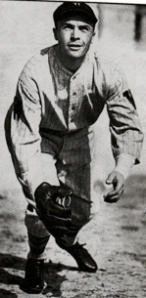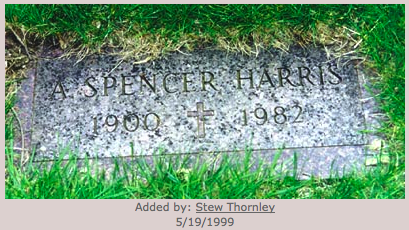In the first part of my Who’s Who of The Far West League, I mentioned that minor league baseball’s all-time hits leader, Spencer Harris (also referred to as Spence Harris), ended his 28-year playing career as player/manager at Marysville during the FWL’s first season in 1948. I went through the Marysville Appeal-Democrat for August 1948 to see if the locals were wowed to have this minor league legend in their midst, and near as I can tell, they had no idea.
The 1949 Sporting News Baseball Guide lists Harris as taking over as Marysville manager on August 14, but the Appeal-Democrat reported he signed on August 18 and managed his first game that night. The Braves were 48-54 when Harris arrived, then went 11-9 under his guidance; Harris helped his own cause by hitting .361 and scored nine runs in 11 games.
All the Appeal-Democrat had to say about Harris’ career when he arrived was what he had done with Yakima of the Western International League so far that season and the year before. There was no hint that he was the minor leagues’ all-time leader in hits, runs, doubles and total bases, or that he had been one of the American Association’s top outfielders from the late 1920s through the mid-’30s.
The Appeal-Democrat story announcing Harris’ arrival said he was 45, but he had actually turned 48 years old the previous week. I have no other documents from any point in his career that list his age, so I don’t know if he presented himself as younger than he was, but I have found evidence of his birth certificate that says he was born in Duluth, Minn., on August 12, 1900. By the time Harris arrived in Marysville he had already played more than 3,200 minor league games dating back to 1921, plus another 164 in the majors (two full seasons as a backup with the White Sox in 1925-26, plus brief stints with the Senators in 1929 and the A’s in 1930).
Harris played at the highest minor league level from 1928 through 1945, first in the American Association, where he hit over .300 in all ten of his seasons with Minneapolis:
| Year | G | AB | H | 2B | 3B | HR | BA |
|---|---|---|---|---|---|---|---|
| 1928 | 169 | 669 | 219 | 41 | 4 | 32 | .327 |
| 1929 | 154 | 594 | 202 | 42 | 7 | 14 | .340 |
| 1930 | 93 | 369 | 134 | 24 | 7 | 10 | .363 |
| 1931 | 163 | 642 | 223 | 40 | 12 | 15 | .347 |
| 1932 | 129 | 469 | 165 | 33 | 7 | 17 | .352 |
| 1933 | 152 | 631 | 224 | 47 | 10 | 22 | .355 |
| 1934 | 150 | 614 | 198 | 29 | 8 | 16 | .322 |
| 1935 | 127 | 486 | 164 | 25 | 4 | 16 | .337 |
| 1936 | 150 | 595 | 179 | 30 | 10 | 15 | .301 |
| 1937 | 88 | 258 | 84 | 12 | 4 | 9 | .326 |
Harris led the AA in runs three times during that stretch and scored more than 100 runs eight times (he scored 99 in 1930 when he played part of the season with the A’s). He also drove in at least 100 runs six times and led the league in doubles and homers in 1928. Minneapolis’ cozy Nicollet Park was good for Harris’ power stroke. He hit 64% of his career minor league home runs (166 of 258) as a Miller, even though he played just 42% of his career games (1375 of 3258) for the team.
After the 1937 season Harris was traded for Ted Williams, although that’s all but forgotten. Williams’ pages on Baseball-Reference.com and Retrosheet both say he was signed by the Red Sox in 1936; he actually signed with his hometown San Diego Padres after his high school year finished in 1936 (he would not graduate until that winter), then the Padres dealt him to the Red Sox in December 1937. James D. Smith, writing in “The Kid: Ted Williams in San Diego,” edited by Bill Nowlin, said the Red Sox acquired Williams “for a reported $35,000 (plus Dom Dallesandro and Al Niemiec, later Spencer Harris. Some accounts place the figure at $25,000.)”
I don’t know when “later” came; Williams doesn’t mention Harris as part of the deal in his autobiography, “My Turn at Bat.” But in any event Harris played for San Diego in 1938 to start an eight-year stretch in the Pacific Coast League. He was 41 when Pearl Harbor was bombed and thus was able to play through the war. The photo below is from Bill O’Neal’s book “The Pacific Coast League 1903-1988.”
 (The scan of the photo above was provided by Bo Kinney of the Seattle Public Library, who has been extraordinarily helpful.)
(The scan of the photo above was provided by Bo Kinney of the Seattle Public Library, who has been extraordinarily helpful.)
Harris finished his career with 3,617 hits, but never once led his league in a season. He also never won a batting title. (The most career hits by a major leaguer who never led his league in hits in a season was 3,315 by Eddie Collins. In an odd coincidence, Collins was the Red Sox executive who traded Harris for Ted Williams!)
“He was never thought of as the top player on his many minor league clubs,” Bob Hoie wrote of Harris in his article on minor league baseball in the fifth edition of “Total Baseball,” “just as a good solid player of the type that formed the backbone of the minors for so many years.”

Photo published in the Seattle Times in 1941, scan provided by Bo Kinney of the Seattle Public Library
Longevity clearly played a role in Harris’ record totals. He had at least 730 hits after his 40th birthday, not counting any hits that came during the 1940 season after his birthday. (Pete Rose, the 20th century major league leader in this category, had 691 hits after his 40th birthday in 1981.)
So far this account of Spencer Harris has been numerically oriented, largely for lack of other available material. For a man who had such a long playing career and who holds such significant career records, remarkably little has been written about Harris; my inquiries to noted experts in minor league history have turned up very little about the man. His entry in the Biographical Dictionary of American Sports provides a few details…but only a few. (UPDATE 3/7/10: Bill Francis of the Baseball Hall of Fame library passed along some items from Harris’ file there that has allowed me to flesh this out just a little bit.) Here’s a summary of what little I know:
As mentioned, Harris was born in Duluth, but it’s unknown how long he stayed there. On a questionnaire, filled out (apparently) in 1969 and on file at the Hall of Fame, he said he attended elementary school in Milwaukee, Duluth and Seattle, where he also attended Broadway High School (the former Seattle High School, later part of Seattle Community College). He lists his graduation year as 1921, which would have made him 20 years old when he finished high school (date of birth August 12, 1900, which appears on both his birth and death certificates).
Bo Kinney at the Seattle Public Library tells me Harris is listed in the 1919 Broadway High School yearbook as a member of the sophomore class, but Harris is not listed in any of the classes (sophomore, junior and senior) in the 1920 yearbook. Kinney says Harris is manager (with Bill Graham) of the baseball team in 1920, and says he is on the Broadway baseball team in 1921. He is not mentioned in the 1922 yearbook.
The prescient prognostication below is from the 1919 Broadway High yearbook (scanned by Bo Kinney):
Here is a photo of Harris and the Broadway High baseball team from that 1919 yearbook…Harris is in the back row at the far left.
Harris began his professional career in 1921 with Tacoma of the Pacific Coast International League and would appear not to have joined the team until after the school year ended. An undated clipping by Ernest J. Lanigan, perhaps from his 1922 Baseball Cyclopedia, says he homered in his first professional time at bat, off Jim Marquis of Vancouver, but hit just one more home run in his 71 games that season.
There’s another clipping about Harris in the Hall of Fame file, this one apparently from The Sporting News in March 1930, right after the Philadelphia A’s claimed Harris on waivers from Detroit, which had drafted him from Minneapolis the previous winter. Stoney McLinn mentions A’s owner Connie Mack “had him when he was 21 years old, but did not even take him to a training camp then,” going on to mention the A’s bought him from Tacoma in 1921. Perhaps this explains why Harris would have been in the Baseball Cyclopedia (if indeed that’s where he was) under “New Major Leaguers” in 1922, when he would have been 21 years old.
At any rate Harris wound up in Class B ball at Bay City (Mich.) from 1922 through 1924…he was there on option from the A’s the first two seasons, then was sold to the team. He then was purchased by the White Sox and spent two undistinguished seasons with them as a reserve in 1925 and ’26. He was sold again, to Shreveport of the Texas League, hit .354 with 60 doubles in 1927, then went on to start his ten-year run in Minneapolis, with exceptions for brief stints with the Senators at the start of 1929 and the A’s at the start of 1930.
Bo Kinney found a number of references to Spencer Harris as a basketball player in the archives of the Seattle Times and passed some of them on to me. In December 1923, Harris was reported receiving a salary to play for a team in Leavenworth, Washington, just on the other side of the Cascade Mountains, and another story from January 1925 shows Harris as a starting forward (at 5’9″) for the Leavenworth five. Harris may have also been working as a basketball referee, based on a story from March 1927 that said Harris would be unavailable to play for a team of Seattle officials in a postseason game against a high school all-star team (Harris had already left for spring training). A story from December 1927 reported Harris as a prominent member of a team that “represents some of the highest calibered basketball men in the city,” along with two former University of Washington stars, that had just played a preseason game against the UW varsity.
Further investigation found Harris played basketball all four years he was at Broadway High…this team photo is from the 1920 yearbook, Harris is fifth from the left.
Kinney also says Harris was listed in the Seattle city directories, as either a “ball player” or “baseball player,” through 1933, so it would seem he continued to make his home in the city where he went to high school until he was well into his baseball career. Apparently he did not marry until 1935.
Harris played 114 games in the Pacific Coast League in 1945. But in 1946, with the war over, there was no room for a 45-year-old in the PCL, and Harris went to Yakima of the Class B Western International League, the first time he had played at that low a level since 1924. He was player-manager of the Stars, and his third baseman was former St. Louis Browns standout Harlond Clift. In 1947 Harris stayed with Yakima as a player only, with Clift taking over as manager, his only year as a skipper. Harris was a player only at Yakima again in 1948 before he went to Marysville.
After that we have record of Harris spending only one other season in uniform: 1956, when he managed the North Platte Indians of the revived Class D Nebraska State League. There he was Jim Perry‘s first professional manager. I have no idea what he was doing between Marysville and North Platte. The only other record we have of his involvement with baseball is that he seems to have been a scout for the Mets in 1962.
Minneapolis baseball history expert Stew Thornley checked Harris’ obituary in the Minneapolis Tribune; according to that, Harris and his wife settled in Minneapolis in 1956 and he apparently spent the rest of his life there. His wife died in November 1957. Harris worked as a salesman at Justers, a men’s clothing store in downtown Minneapolis. The obituary mentioned that he played in a slow-pitch league at the age of 63 and spent a lot of time in his later years playing golf at the Hiawatha Golf Course.
He died in Minneapolis on July 3, 1982, and was buried in Lakewood Cemetery. His death certificate says he died at University Hospitals as a result of hypertension…officially, congestive heart failure due to hypertensive heart disease due to a Goldblatt kidney. He also had a perforated duodenal ulcer.
Here’s something I love…from that 1969 questionnaire Harris filled out for the Hall of Fame Library:
Access to the digital archives of The Sporting News is unavailable at this time due to a technical problem, so I have not been able to access Harris’ TSN obituary or do any other searching in the TSN archives for information about his career. That will come eventually.
By the way, Anthony Spencer Harris, the baseball player, is not to be confused with Spencer F. Harris, who was general manager of the Pacific Coast League’s Spokane team until he died at age 60 in 1964.








I think it’s great whenever anyone celebrates the old-time minor leaguers. Harris was special, no doubt. Please see my wordpress blog pertaining to the old American Association: http://www.theoldaa.wordpress.com or my other A.A. blog at http://www.almanacpark.blogspot.com in addition to my website. And please keep working on Harris!
Thanks, Rex…I had checked theoldaa blog as I was researching this to see if you had anything on Spencer. I enjoy your work. As I get more on Harris I’ll add it here, so stay tuned!
Pingback: Spencer Harris, hit king/basketball player « The J.G. Preston Experience
Pingback: Letterhead of The Far West League « The J.G. Preston Experience
When A. Spencer Harris died my father, John Harris McGivern, ended up being the executor of his will and was asked by the Chicago museum (not sure which one) if my dad would sell them Spencer’s baseball mitt for $3000. My dad did. I used to have Spencer’s wrist watch until my ex stole it and sold it. I also used to have his original marriage licence that another ex in-law stole. It was beautiful and I was going to copy some of the border art from it until… I am totally fascinated by Spencer tho I am a distant relative. Maybe Spencer’s affinity for baseball and basketball over the other team sports runs in the family as those two have always been my favorites also. Please continue your search for data in honor of Spencer as my facination and curiosity have been aroused again by you. Thank you for your love of the game and for honoring Spencer. He never got the attention or glory he really deserved until maybe now by you. My grandmother was Margaret Mildred Harris and my great-grandfather was Ted Harris both of MN. Namaste. Maureen McGivern Horrobin